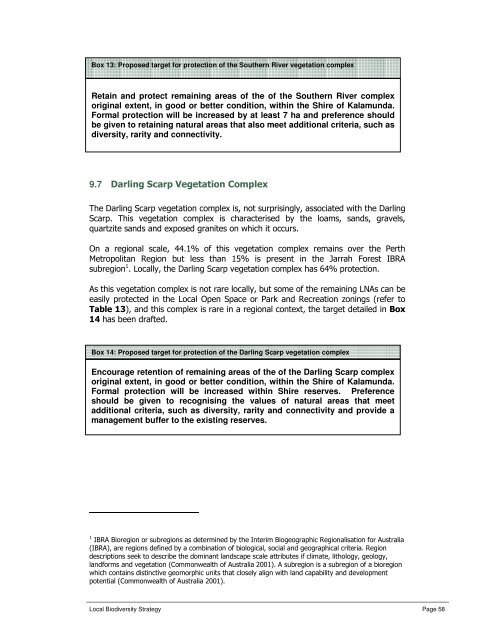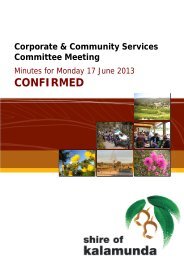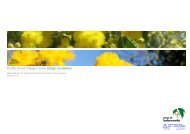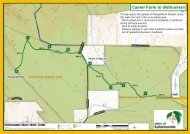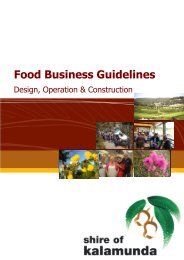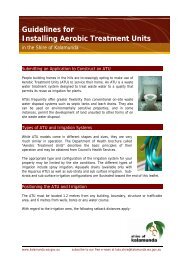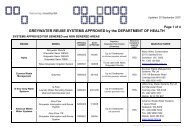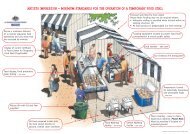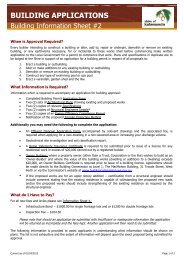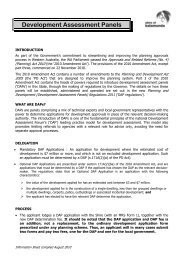Local Biodiversity Strategy: - Shire of Kalamunda
Local Biodiversity Strategy: - Shire of Kalamunda
Local Biodiversity Strategy: - Shire of Kalamunda
You also want an ePaper? Increase the reach of your titles
YUMPU automatically turns print PDFs into web optimized ePapers that Google loves.
Box 13: Proposed target for protection <strong>of</strong> the Southern River vegetation complex<br />
Retain and protect remaining areas <strong>of</strong> the <strong>of</strong> the Southern River complex<br />
original extent, in good or better condition, within the <strong>Shire</strong> <strong>of</strong> <strong>Kalamunda</strong>.<br />
Formal protection will be increased by at least 7 ha and preference should<br />
be given to retaining natural areas that also meet additional criteria, such as<br />
diversity, rarity and connectivity.<br />
9.7 Darling Scarp Vegetation Complex<br />
The Darling Scarp vegetation complex is, not surprisingly, associated with the Darling<br />
Scarp. This vegetation complex is characterised by the loams, sands, gravels,<br />
quartzite sands and exposed granites on which it occurs.<br />
On a regional scale, 44.1% <strong>of</strong> this vegetation complex remains over the Perth<br />
Metropolitan Region but less than 15% is present in the Jarrah Forest IBRA<br />
subregion 1 . <strong>Local</strong>ly, the Darling Scarp vegetation complex has 64% protection.<br />
As this vegetation complex is not rare locally, but some <strong>of</strong> the remaining LNAs can be<br />
easily protected in the <strong>Local</strong> Open Space or Park and Recreation zonings (refer to<br />
Table 13), and this complex is rare in a regional context, the target detailed in Box<br />
14 has been drafted.<br />
Box 14: Proposed target for protection <strong>of</strong> the Darling Scarp vegetation complex<br />
Encourage retention <strong>of</strong> remaining areas <strong>of</strong> the <strong>of</strong> the Darling Scarp complex<br />
original extent, in good or better condition, within the <strong>Shire</strong> <strong>of</strong> <strong>Kalamunda</strong>.<br />
Formal protection will be increased within <strong>Shire</strong> reserves. Preference<br />
should be given to recognising the values <strong>of</strong> natural areas that meet<br />
additional criteria, such as diversity, rarity and connectivity and provide a<br />
management buffer to the existing reserves.<br />
1 IBRA Bioregion or subregions as determined by the Interim Biogeographic Regionalisation for Australia<br />
(IBRA), are regions defined by a combination <strong>of</strong> biological, social and geographical criteria. Region<br />
descriptions seek to describe the dominant landscape scale attributes if climate, lithology, geology,<br />
landforms and vegetation (Commonwealth <strong>of</strong> Australia 2001). A subregion is a subregion <strong>of</strong> a bioregion<br />
which contains distinctive geomorphic units that closely align with land capability and development<br />
potential (Commonwealth <strong>of</strong> Australia 2001).<br />
<strong>Local</strong> <strong>Biodiversity</strong> <strong>Strategy</strong> Page 58


